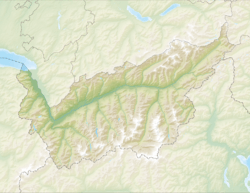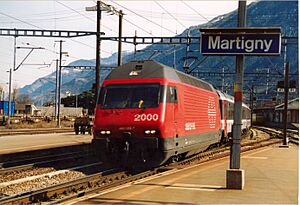Martigny facts for kids
Quick facts for kids
Martigny
|
||
|---|---|---|
 |
||
|
||
| Country | Switzerland | |
| Canton | Valais | |
| District | Martigny | |
| Area | ||
| • Total | 32.6 km2 (12.6 sq mi) | |
| Elevation | 471 m (1,545 ft) | |
| Population
(Dec 2020 )
|
||
| • Total | 18,291 | |
| • Density | 561.1/km2 (1,453.2/sq mi) | |
| Demonym(s) | Les Martignerains | |
| Postal code |
1920
|
|
| Localities | Chemin-Dessous, La Bâtiaz, La Verrerie, Le Guercet, Martigny-Bourg, Martigny-Ville | |
| Surrounded by | Bovernier, Dorénaz, Fully, Martigny-Combe, Salvan, Vernayaz, Vollèges | |
| Twin towns | Vaison-la-Romaine (France), Sursee (Switzerland) | |
Martigny is a city in the Canton of Valais, Switzerland. It sits at an elevation of about 471 meters (1,545 feet). Around 20,000 people live here. Martigny is a very important place because it connects roads from Italy, France, and Switzerland.
One road goes over the Great St. Bernard Pass to Aosta in Italy. Another road goes over the col de la Forclaz to Chamonix in France. In winter, Martigny is a great base for visiting many nearby ski resorts like Verbier.
Contents
- Exploring Martigny's Location
- A Journey Through Martigny's Past
- Martigny's Coat of Arms
- People and Population
- Important Cultural Sites
- Economy and Agriculture
- Religion in Martigny
- Sports in Martigny
- Education and Learning
- Getting Around Martigny
- Famous People from Martigny
- Martigny's International Friends
- Images for kids
- See also
Exploring Martigny's Location
Martigny is located about 33 kilometers (20 miles) south-southeast of Montreux. It lies on the left side of the Rhône Valley, at the foot of the Swiss Alps. This is where the Rhône River makes a sharp turn from flowing southwest to heading north towards Lake Geneva.
The La Drance river flows from the southern Valais Alps and joins the Rhône right after its turn.
Land Use in Martigny
Martigny covers an area of about 24.97 square kilometers (9.64 square miles).
- About 31.5% of the land is used for farming.
- Nearly 40% is covered by forests.
- About 23.3% has buildings or roads.
- The remaining 5.3% is unproductive land.
How Martigny Became One City
In 1964, the current city of Martigny was formed. This happened when the smaller towns of Martigny-Ville and Martigny-Bourg joined together. On January 1, 2021, the town of Charrat also became part of Martigny.
A Journey Through Martigny's Past
Martigny has a very long and interesting history, dating back to ancient times.
Early Settlements and Roman Times
Around the 1st century BC, a settlement called Octodurus or Octodurum existed here. It was home to the Veragri people. In 57 BC, the Roman Republic took control of Octodurus. A Roman general named Servius Galba stayed here with his soldiers. Their job was to protect the important Great Saint Bernard Pass, which traders used.
Galba's army was suddenly attacked by the Gauls in the Battle of Octodurus. The Romans won, but it was a tough fight. After this, Galba decided to burn the settlement and leave.
Later, Octodurus became part of the Roman Empire. Between AD 41 and 47, a new Roman colony called Forum Claudii Augusti was built nearby. It became the capital of the Vallis Poenina province.
Martigny in the Middle Ages
In the 4th century, Martigny became an important religious center with a bishop. This makes the Roman Catholic Diocese of Sion the oldest bishopric in Switzerland. The first known bishop was Theodulus, who died in 391.
During the Middle Ages, the town was named Martinach after Martin of Tours, its patron saint. This name later became Martigny. In 1351, the town came under the protection of the House of Savoy.
Modern History and Growth
Martigny's economy mostly relied on farming and growing grapes for wine. The Dranse river often flooded the town, causing damage in 1595 and 1818.
From 1798 to 1814, Martigny was part of different French-controlled republics under Napoleon. In 1815, it finally became part of Switzerland.
In the 1830s, Martigny was divided into smaller towns. But in the 20th century, these parts started joining back together. Martigny-Ville merged with La Bâtiaz in 1956, and with Martigny-Bourg in 1964.
Martigny got its first railway connection in 1878. A new train station was built in 1906. In 1981, it was connected to the Swiss motorway system. The city's population grew from 2,545 people in 1850 to 18,269 in 2020.
Martigny's Coat of Arms
The official symbol of Martigny is a red shield with a silver lion standing up. The lion holds a golden hammer.
People and Population
Martigny is home to many people from different backgrounds. As of 2008, about 30.6% of the people living in Martigny were foreign nationals. The population grew by 13.1% between 2000 and 2010.
Languages Spoken in Martigny
Most people in Martigny speak French as their main language.
- About 85.1% speak French.
- Portuguese is the second most common language (4.2%).
- Italian is the third most common (4.2%).
- A smaller number of people speak German or Romansh.
Age Groups in Martigny
Looking at the age of people in Martigny (as of 2000):
- Children and teenagers (0–19 years old) make up 23.8% of the population.
- Adults (20–64 years old) make up 61.3%.
- Seniors (over 64 years old) make up 14.8%.
Important Cultural Sites
Martigny has several places that are considered important national heritage sites. These include:
- The Centre valaisan du film (Valais Film Center).
- La Bâtiaz Castle.
- Three museums: the Gallo-Roman Museum, the Car Museum, and the Fondation Pierre Gianadda.
- The ancient Roman city remains.
Culture and the Gianadda Museum
The Romans left many historical remains in Martigny. The city is famous for its amphitheater, which was restored in 1978. Sometimes, traditional cow fights are held here in early autumn.
The Fondation Pierre Gianadda is the most important cultural attraction in Martigny. It includes the Gallo-Roman Museum and a car museum. The building itself was built around the remains of an old Roman temple. The foundation also hosts three art exhibitions each year, showing works by famous artists.
Economy and Agriculture
Martigny is an important business center. It is the headquarters for the Groupe Mutuel, an insurance company, and the watch brand 121TIME.
The city is surrounded by many vineyards and orchards. The warm sunshine in Valais is perfect for growing strawberries, apricots, asparagus, and grapes for wine. These crops grow on the hills and steep slopes around the city. The Dranse River flows into the Rhône in the valley where Martigny is located.
Jobs and Work in Martigny
As of 2010, Martigny had an unemployment rate of 6.5%. In 2008, there were many jobs in different areas:
- Primary sector (farming, forestry): 251 people worked in this area.
- Secondary sector (manufacturing, construction): 2,211 people worked here.
- Tertiary sector (services like sales, transport, healthcare, education): 7,812 people worked in this sector.
About 44.2% of the workers in Martigny were women. Many people travel into Martigny for work each day. About 10.4% of workers use public transport, and 58.8% use a private car.
Religion in Martigny
Based on the 2000 census, most people in Martigny are Roman Catholic (77.2%). About 5.0% belong to the Swiss Reformed Church. There are also smaller groups of Orthodox Christians, Christian Catholics, and other Christian churches. About 4.85% of the population is Islamic. Some people also follow Buddhism, Hinduism, or no religion at all.
Sports in Martigny
Martigny has a strong sports scene:
- Ice Hockey: The local ice hockey team, HCV Martigny, plays in the Swiss League (SL). Their home arena is the Forum d'Octodure.
- Football: FC Martigny-Sports is the city's amateur football team.
Education and Learning
Education is important in Martigny. About 31.5% of the population has completed higher secondary education. Another 10.4% have gone on to complete university or other higher education.
Martigny is home to the Médiathèque Valais - Martigny library. In 2008, the library had over 57,756 books and other media. It loaned out 144,524 items that year.
Getting Around Martigny
Martigny is a major transportation hub.
Train Connections
Martigny is on the high-speed Simplon line of the Swiss Federal Railway (SBB). This line connects Italy and southern Switzerland to northeastern Switzerland, including the cities of Lausanne and Geneva.
Martigny is also the starting point for smaller, narrow-gauge railways and bus routes that go into the nearby mountains.
- One railway goes west to Chamonix, France, called the Mont-Blanc Express.
- Another railway goes southeast to Chable and Orsieres, called the St. Bernard Express.
These services are run by the TMR SA (Transports de Martigny et Regions) company. Thanks to these connections, popular winter sports areas like "4 Vallées" and Portes-du-Soleil are easy to reach from Martigny.
The TMR SA company is an important employer in the region, with about 180 permanent staff.
Famous People from Martigny
Many notable people have connections to Martigny:
- François Couchepin (born 1935), a Swiss lawyer and former politician.
- Pascal Couchepin (born 1942), a politician who was President of the Swiss Confederation in 2003 and 2008.
- Nicolas Puech (born 1943), a French billionaire and businessman who lives in Martigny.
- Stéphane Lambiel (born 1985), a famous figure skater and coach, who was a two-time World champion.
- Justin Murisier (born 1992), a Swiss World Cup alpine ski racer.
Martigny's International Friends
Martigny has special connections with other cities around the world. These are called "twin towns" or "sister cities."
|
|
Images for kids
See also
 In Spanish: Martigny (Valais) para niños
In Spanish: Martigny (Valais) para niños








